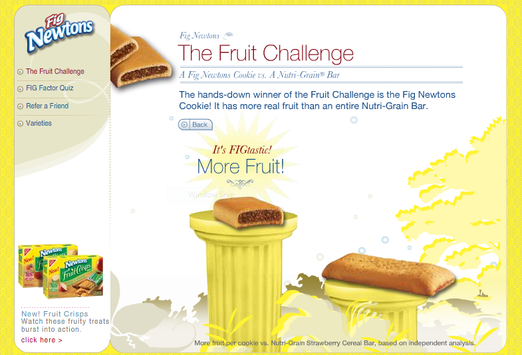Well, class officially ends tonight at 5 PM when everything on our websites is due. The end of the semester always has a lot of stress but this semester, I am confident in the work I have produced! I may even maintain my we
Wow! Everyone's Collaborative Research Project was amazing! I learned so much from just listening to each group present their research and I was impressed at how creative and interesting everyone's topic was! I am also so proud of my own group. I think we produced a solid project with great information for our classmates and anyone else who is interested in learning more about healthier eating!
Please take a look at our website to see our entire project titled "Selling the Narrative" The end of the semester is usually the most stressful, papers need to be written, presentations need to be given and final grades are calculated.. what better time for a computer to crash? Especially one with no files backed up. The past couple days have been.. awful.
Granted, it is my own fault for not backing up my files and storing my work on an exterior hard drive but does this have to happen now?! With less than two weeks left in the semester?? What's done is done and I just have to gather up whatever hard copies of papers I have and keep them in a safe place until I am able to store them safely back on my computer AND an outside hard drive. On a lighter note, our group project and my individual assignments are coming along nicely! Our final interview is scheduled for tomorrow and after that we do not have much work left on that assignment. Thankfully, majority of the work for WRT has been online! Well, I'd better get back to work on the Collaborative Research Project and Twitterive! Today in class we made significant progress with our collaborative research assignment. Linsey, Megan and I made some decisions regarding the overall format of our presentation (we are designing a website to present our research and interviews) and we have delegated remaining responsibilities. I am very excited for our second interview on Friday afternoon with Natural Health! We will either be speaking with a manager or an associate from the store and we will be asking them several questions regarding the products they sell and their personal lifestyle changes since starting their job at Natural Health. Natural Health is an interesting store and it is situated at a busy intersection in Blackwood. In addition to health food, Natural Health provides customers with top of the line all-natural health food products and other natural supplements and essential oils. The benefits of using essential oils in baths and craft projects make purchasing some oils a great investment and the dedicated workers of Natural Health are always looking to help!
In our research for the collaborative research project, my group members and I decided to break down the food industry into 3 main areas: meat, produce and grain products (snack foods, fiber bars, ect). I decided I would look into the grains portion and I am focusing on the Nabisco company. Nabisco is a very large company and markets several brands - everything from Honey Made Crackers to Nilla Waffers. The advertising for these products varies depending on to whom they are marketed but it is interesting to discover that many of these products are geared toward children.
However, there are benefits to providing children with snacks from Nabisco. When comparing Nabisco with another fruit snack producing company (such as Nutri-Grain), the better choice is the Fig Newton cookie from Nabisco. When researching healthy snacks for this portion of the assignment, I was surprised that some of the better choices turn out to come from brands that I have always associated with producing junk food - what a nice surprs Lindsay, Megan and I are pretty excited about our research project! After our class discussion this week about working collaboratively, the issues involving co-writing has helped me to understand the way this project is going to work when it comes down to the writing. Although I've done group writing projects before, this project is different because of the research involved. Since we have three members in our group, it is easier to break off on our own, dig deep into our topic and reconvene with all of our information. We have all come up with ideas that the other members have not considered and this is allowing for our project to have more depth than it could have had if we worked indivi
Required Sources:
1. Berry, Wendell. "The Pleasures of Eating." Center for Ecoliteracy. N.p., 1990. Web. 27 Mar 2011. <http://www.ecoliteracy.org/essays/pleasures-eating>. This article provides the author urges consumers to become aware of the process involved in producing the food we eat every day. If we remain unaware of the conditions the animals endure before being processed for human consumption, nothing will change. Without people educating themselves about the possible dangers of infection and disease, we will continue to endanger ourselves and future generations. 2. Fontaine, Sheryl I., and Susan M. Hunter. “Chapter 1: You Think/I Think; Therefore, We Are: How Do I Need to Think About Knowledge and Language if I Am to Write Collaboratively? Because we are working collaboratively on this significant assignment, it becomes important to understand group dynamics and how individuals participate in activities related to the assignment. In order to have successful group relations, Fontaine and Hunter encourage regular communication between group members to ensure the process runs smoothly. 3. Food Inc. Dir. Robert Kenner, Eric Schlosser, and Elise Pearlstein. Magnolia Pictures, 2008. DVD. As this film states at the end of the production, consumers vote for the way food will be produced - three times a day. We as consumers have a responsibility to ourselves to remain informed about the food we eat. If we sit back and passively accept the food in the condition it is presented to us, there will be no changes made to the process. 4. Schlosser, Eric. “Introduction.” Fast Food Nation: The Dark Side of the All-American Meal. Houghton Mifflin, 2001. Writing, Research, and Technology. Web. 1 April 2011. Too often financial situations dictate the quality of food a person is able to posses. Because fast food and mass produced and packaged food is inexpensive and easily accessible, people in the lower end of the socioeconomic scale are forced to eat this food and feed it to their children. 5. Qualley, Donna. “Understanding Reflexivity.” Turns of Thought. Portsmouth: Boynton/Cook (Heinemann), 1997. 8-30. Writing, Research, and Technology. Web. 3 March 2011. Qualley is an educator who firmly believes in allowing students to create and work collaboratively with other students to produce a better piece of work. She makes the distinction between reflexive and reflective thoughts. This distinction helps people to understand how to process new pieces of information and learn understand new ideas. My Sources: 1. Is This the Most Dangerous Food for Men? http://www.menshealth.com/nutrition/soys-negative-effects This article discusses the possible dangerous side effects for men eating too much soy. Men who are lactose intolerant seem to be particularly negatively affected by soy since their soy intake tends to be higher than men who are able to eat dairy without a problem. Similar to the concerns for women who ingest too much soy, men are experiencing hormone imbalances when consuming too much soy. 2. The Dangers of Estrogen in Soy Milk http://www.livestrong.com/article/339238-the-dangers-of-estrogen-in-soy-milk/ Too much soy milk for women has been a concern for several years. This article discusses the impact soy can have on women's overall health. 3. 'Added Sugar' May Add to Weight Gain in U.S. http://www.webmd.com/diet/news/20110324/added-sugar-may-add-to-weight- gain-in-us?ecd=wnl_wmh_040611 With the typical diet of the average American becoming more focused on the convience of fast food, increased amounts of sugar is a possible cause for weight gain in many Americans. 4.FDA Looking into Food Dye, ADHD Link http://www.cbsnews.com/video/watch/?id=7361287n Many people, especially mother's are becoming more concerned with the affects food dye has on their children who are diagnosed with ADHD. So far, no link has been determined between certain food dyes and ADHD but the FDA is currently doing tests to find out definitively if parents of children with ADHD should be more concerned about the food they are feeding their children. 5. Three Killed in Chinese Milk Scare http://www.foodproductiondaily.com/Quality-Safety/Three-killed-in-new-Chinese-milk-scare This article discusses the impact radioactivity has had on the production of milk in China. The dangers exist for anyone consuming the contaminated milk but the main concern is the children of the country. This is your new blog post. Click here and start typing, or drag in elements from the top bar. 1. What effect is human food production having on animals we consume (cows and pigs) and the animals we do not eat (birds and other wildlife)?'
2. What is New Jersey doing to protect consumers? 3. Which laws could be improved to allow the average consumer more information in the grocery store? 4. Should elementary schools put more emphasis on helping students understand the difference between healthy and not healthy foods? 5. What role does the media play in the food production business? 6. How can young people become involved in changing the system? 7. Why is there so much emphasis on convenience rather than "goodness" in our society? 8. Can American look to foreign countries for suggestions on improving the food business? 9. How have recent changes in dietary necessities affected our lifestyles (food pyramid)? 10. Do consumers "have a right to know" or will it cause "unnecessary When faced with the realities of food production and distribution in America, many are concerned about what can be done to stop the dangerous practices of food production companies. Wendell Berry's response? "Eat responsibly."
Berry lists several questions "responsible" eaters should consider when wandering the aisles of the grocery store including: 1. How far was it transported, and what did transportation add to the cost? 2. How much did manufacturing or packaging or advertising add to the cost? 3. When the food product has been manufactured or "processed" or "precooked," how has that affected its quality or price or nutritional value? But our decisions should not be based solely on the fact that our food was produced on a farm. It is important to know where, what kind of farm it is and have a general idea of the farming practices on the farm. Berry reflects on the idea that the average consumer is literally spoon fed their meals. "The food industrialists have by now persuaded millions of consumers to prefer food that is already prepared. They will grow, deliver, and cook your food for you and (just like your mother) beg you to eat it." Since we as consumers are so accustomed to convenience rather than quality, the chances of improvement seem bleak. However, Berry suggests several practical solutions these problems. Qualley begins this piece by essentially explaining the role of a teacher in a classroom. Traditionally, teachers are expected to pass on information and insight to students and students are expected to reiterate what they learned in some form of assessment. However, Qualley reflects on the importance of teachers being open minded to the possibility of learning something themselves. This is further supported by her awareness of constantly revising and improving ones own work as a teacher. Qualley cites Donald Murray's writings to be the source of inspiration for her thoughts. Qualley mentions the importance of not "adher[ing] to a single formulation" (4). By this, Murray is suggesting that there are multiple ways to teach writing and it is crucial to adopt more than one method.
Qually favors teaching writing through "methods for reflexive inquiry" (5). Through this method, she teaches writing based on the idea that writing an essay should be based on the "stance the reader/writerz |



 RSS Feed
RSS Feed